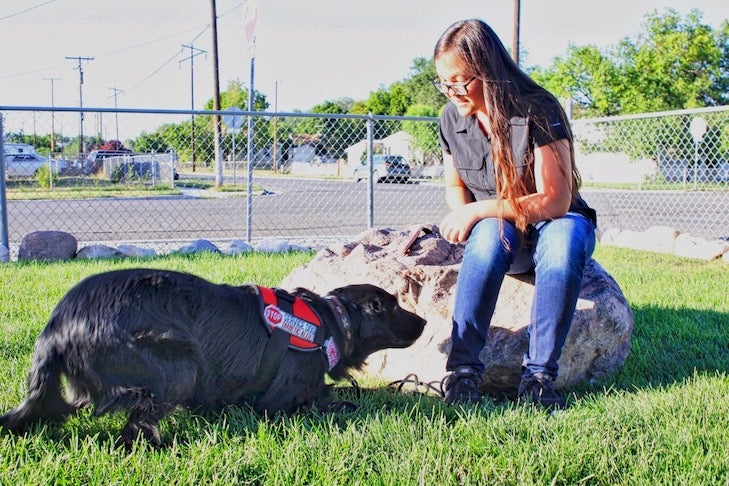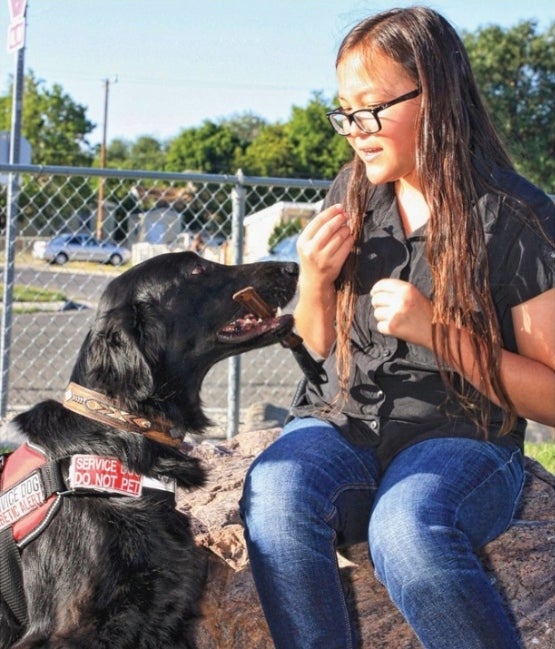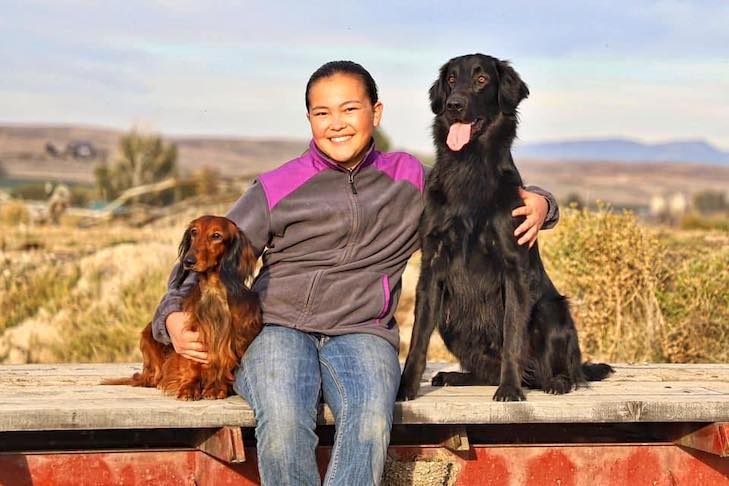
A nose punch to the hand, a play bow, and a swipe with a paw. Add a yip, a lick, and a tug at clothing, and it looks like a dog in hijinks heaven.
These silly shenanigans are all fun and games until someone’s type 1 diabetes fluctuates to a life-threatening level. That’s when a diabetic alert dog (DAD) goes to work and detects the scent the body releases when blood sugars change. Think living medical testing equipment in a furry dog suit and a red service vest, but no batteries are included or required.
A chronic autoimmune disease, diabetes impairs the body’s ability to produce insulin, the hormone that regulates blood sugar levels. But unlike a blood glucose meter that reports a precise measurement, a DAD dog sniffs out the change in blood sugar from a diabetic person’s breath or sweat and quickly performs a specially trained behavior, such as pawing or barking to alert his owner. One of these specific acts lets her know to use a blood glucose meter to test her blood sugar and normalize the condition.
Super Girl
Fourteen-year-old Ava Hata of Riverside, California, seems wise beyond her years. She knows all about diabetes as she was diagnosed with type 1 when she was 18 months old. Ava also knows how a dog trained to detect the highs and lows of the disease can help someone avoid complications from diabetes, like kidney disease, blindness, nerve damage, heart attacks, and even strokes.
At age 10, the youngster began training Bruin, a Flat-Coated Retriever, as her diabetic alert dog. Today she also shows him in AKC conformation, agility, and Junior Showmanship, and he already has AKC novice obedience, Rally, and Farm Dog titles.
To add to her impressive resume, Ava travels to Salt Lake City six times a year and helps a Labrador Retriever breeder train puppies for future careers as diabetic alert dogs. To her credit, Ava has imprinted her diabetic scent and socialized dozens of puppies.
While many youngsters like to spend their time playing video games and visiting with friends, why does this talented teen opt to work with live-action blood chemistry monitors? Why not directly buy a DAD dog?
When Ava was seven years old, her family tried to purchase a trained dog who would let them know when the girl’s blood sugar levels dropped too low or rose too high, but companies they spoke with refused to sell them a dog for a child to manage. And for many families, the $15,000 to $50,000 fee to buy a trained DAD lies far out of their price range.
Once the Hatas found a training company that agreed to sell them a dog for Ava, they began raising money to buy it. They set up a GoFundMe account and friends and local organizations generously contributed. The company encouraged the family to observe weekly training sessions and invited them to accompany the dog on training outings.
“Unfortunately, after two years of saving money and watching the dog perform alerts, we realized he wasn’t well-trained or worth the $15,000, so we decided to look elsewhere,” says Ava. “Between raising enough money from friends and our community to buy the dog and spending so much time with this company, we were naturally disappointed when it didn’t work out.”
Finding the Perfect DAD
The family next met a dog trainer who promised to train a DAD for Ava.
“I was 10 years old and helped her exercise dogs and practice obedience drills every day,” Ava recalls. “The trainer seemed skillful with the dogs, but I found it difficult to understand her instructions. We decided to buy a dog from another source, but she referred us to another breeder.”
Originally Ava wanted a Labrador Retriever puppy, but after someone suggested a Flat-Coated Retriever and described the breed as the Peter Pan of the retriever world, Ava went for its fun-loving reputation. The Hatas contacted Joyce Brackney of Shasta Flat-Coated Retrievers in Yreka, California.

Brackney billed the pup as a multipurpose dog and told Ava he would make a great DAD, plus she could show him in conformation and performance events. “Joyce said he would love to work and [would be] equally comfortable hanging out at home with me, so we agreed to buy him,” remembers Ava. “I shipped some of my scent samples to her so the puppy could begin picking up my high and low glucose levels, and we were excited I would finally get a DAD.”
The family brought 8-month-old Bruin home, but he needed additional training. When Ava’s glucose levels dropped or rose, he was alerting but not convincingly enough and he lacked experience being out in public. Since DAD dogs accompany their owners everywhere, the dogs need to ignore distractions and any odd sounds they hear, such as vibrations in a movie theater or the roar of garbage trucks.
Relying on what she learned by observing the first two trainers, Ava tried to sharpen Bruin’s alerting skills herself but figured out she needed some assistance. “Bruin was probably doing some version of alerting when we brought him home, but we didn’t realize it at the time,” she recalls. “It wasn’t a fancy alert, but his nose punch to my hand and his hard stare at me did get our attention.”
Calling in Reinforcements
Ava connected with K.C. Owens of Tattle Tail Scent Dogs, in Salt Lake City, who was eager to help the teen perfect Bruin’s skills.
“Brackney raved about Ava’s solid work ethic and dedication to dogs, so after checking her out I offered to work with her and Bruin,” says Owens.
An AKC Hunt Test judge who competes in obedience, agility, and field trials with her Chesapeake Bay Retrievers, Owens breeds and trains health-tested, AKC-registered Labrador Retriever puppies for
diabetic scent-detection work.
She presents DAD seminars around the world and places puppies from two to three litters a year at 9 to 11 weeks old. “I carefully screen puppy buyers and once the pups go home, I provide a year of classes—either online or in person, in scent detection, public access, obedience, and lifelong support. This way the family and the child build a bond with the dog early on.”
Owens began her program after experiencing autoimmune issues, blood glucose fluctuations, and a type 1 diagnosis.
“When Bravo, one of my two Chesapeake Bay Retrievers, jumped on me, wrapped his front feet around my shoulders in a hug and refused to get off, I realized my blood sugar level dropped dangerously low. I began keeping a log of my blood glucose levels and the dog’s reactions and realized a connection,” says Owens.
Having experience raising litters for hunting and imprinting birds on pups a few days old, Owens uses the same technique with diabetic scent samples, exposing the puppies to 450 high and low readings for the first eight weeks of their lives.
Owens showed Ava how to refine Bruin’s alerting by introducing the dog to a bringsel—a short stick either hanging from a dog’s collar or left in a designated spot in the home that indicates a specific glucose level. At 18 months old, Bruin proved reliable.

As a volunteer, Ava provides scent imprinting to the pups, rewards them when they acknowledge the unique smell, and cleans puppy pens.
“By the time the pups go home, they know the difference between low and high blood sugar levels,” says Ava. “With a low, they use their left front foot to tap someone’s hand, and they use their right foot to tap for a high.”
Although it seems as if this 14-year-old is already an adult, what does Ava want to do when she grows up?
“Learning the ins and outs of the diabetic alert dog world has been a crazy experience,” Ava says. “I never thought I’d want to train DADs when I grew up, but after the sad experiences we had with trainers and companies, I know that’s what I want to do. Kids going through type 1 diabetes need a dog they can trust, and if I can do this for people, I’ll be pretty happy.”
This story originally ran in the November/December 2018 issue of AKC Family Dog magazine.


